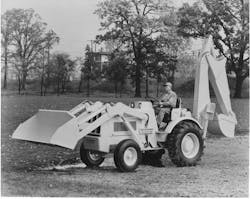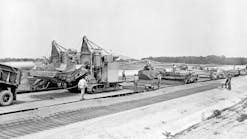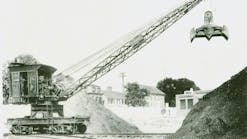The backhoe loader is still one of the most popular and visible of all types of construction machines. It reigned as the mainstay of mechanized utility work over some two-and-a-half decades after first finding popularity in the 1950s.
With the advent of mini excavators, increased popularity of skid steer loaders, and an abundance of companies making compact-sized machines, the backhoe loader still survives. It possesses multi-task capabilities not found in the competition, and is often able to complete all tasks on small jobs with just the one machine. It’s able to excavate, load, lift, backfill, and cleanup, plus more with specialized attachments, and be driven from job to job.
The Historical Construction Equipment Association (HCEA) is a 501(c)3 non-profit organization dedicated to preserving the history of the construction, dredging and surface mining equipment industries. With over 3,800 members in 25 countries, our activities include publication of a quarterly educational magazine, Equipment Echoes, from which this article is adapted; operation of National Construction Equipment Museum and archives in Bowling Green, Ohio; and hosting an annual working exhibition of restored construction equipment. Individual annual memberships are $35 within the US. We seek to develop relationships in the equipment manufacturing industry, and we offer a college scholarship for engineering and construction management students. Information is available at www.hcea.net, or by calling 419.352.5616 or emailing [email protected].
Hy-Dynamic of Lake Bluff, Illinois, was one of many companies entering the backhoe market in the 1950s. In 1959 it introduced its first machine, the famous Dynahoe backhoe loader. Competitive backhoe loaders had originated as agricultural wheel tractors and were generally small and lightly built.
The average backhoe loader in the early 1970s had a digging depth from 14 to 17 feet, an 80-horsepower engine, and weighed 10 tons. However, the Dynahoe was heavily built from the ground up as an excavating machine, and the largest backhoe loader on the market. In contrast, the largest Dynahoe ever offered boasted a digging depth of 20 feet, carried a 155-horsepower engine, and weighed 16 tons.
Hy-Dynamic certainly set out to produce something superior to anything else available. Even the early models from 1959 sported a neat, efficient backhoe linkage, integrated design, and massive frame. Of course, this concept and philosophy resulted in a relatively high purchase price, and consequently the Dynahoe never sold in huge quantities throughout its production life. But it served a niche market for the contractor who wanted extra capacity, production, and mobility.
In 1971 Bucyrus-Erie acquired Hy-Dynamic, and the backhoe loaders were continued as Bucyrus-Erie products with the well-respected Dynahoe name retained. This acquisition came at a time when Bucyrus-Erie’s Construction Equipment Division was at the height of its activity, and demonstrated the company’s desire to capture all segments of that market.
Two years later, Bucyrus-Erie closed the Lake Bluff plant and transferred Dynahoe manufacturing to existing plants at Evansville, Erie, and South Milwaukee. Although not selling in huge quantities like the smaller competitive machines, the Dynahoe continued to serve a niche market and garnered sufficient customers to keep the machines in Bucyrus-Erie’s product line until the company decided to dismantle and sell its entire Construction Equipment Division in 1985.
Northwest Engineering acquired the Dynahoe manufacturing rights and designs. A group of former employees established a new company, Bucyrus Construction Products (BCP) in Erie, Pennsylvania, under the Northwest banner. In 1986, Northwest acquired the Terex brand and made itself a subsidiary of Terex Corp.
Northwest Engineering/BCP continued to build Dynahoes. In the late 1980s, Terex shuffled its various divisions and BCP became an affiliate of Koehring Cranes & Excavators, another Terex division. Sales continued to dwindle as they had for years, and the last Dynahoe was shipped from the factory in 1993.





